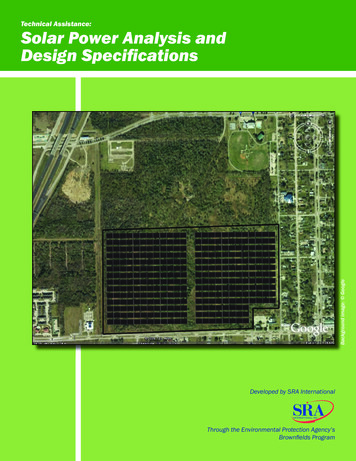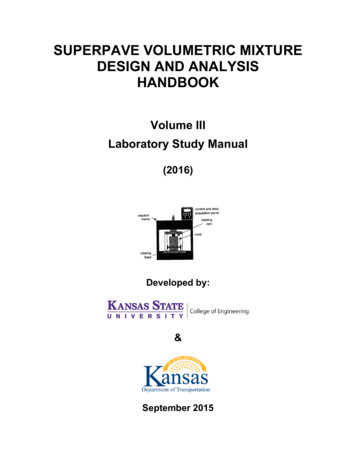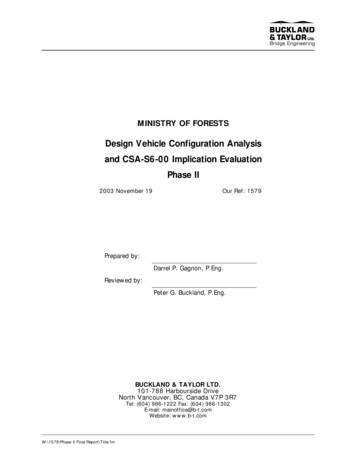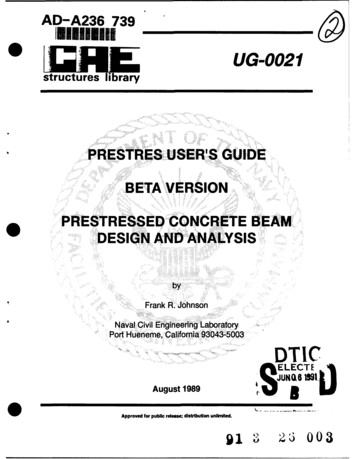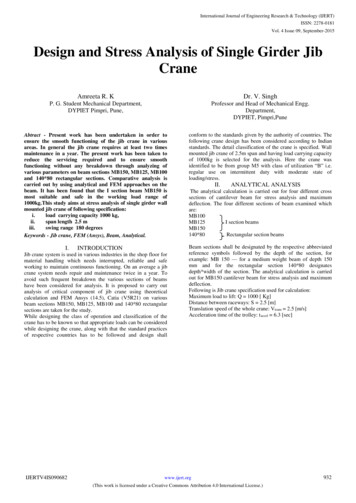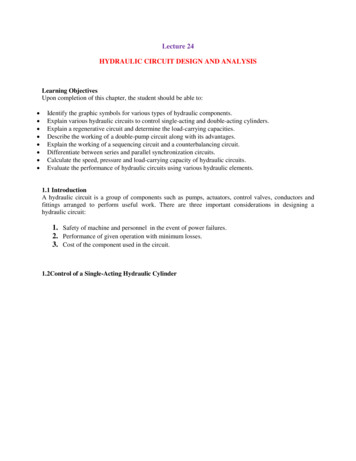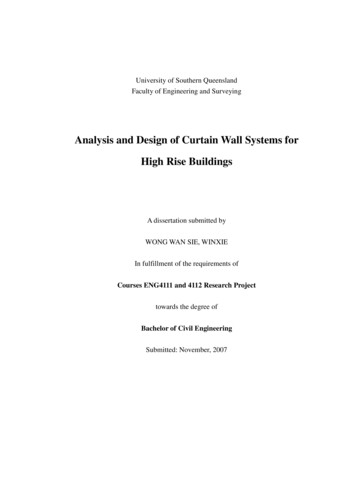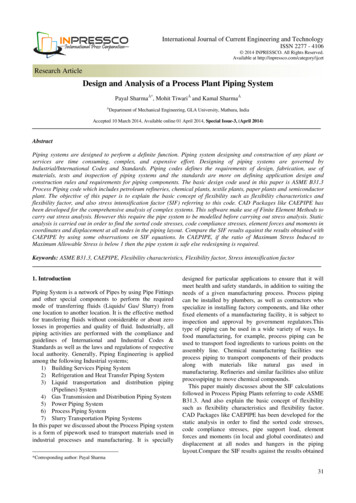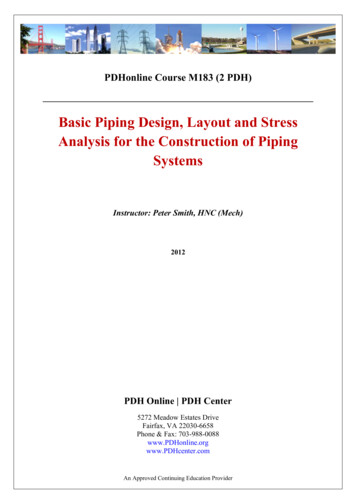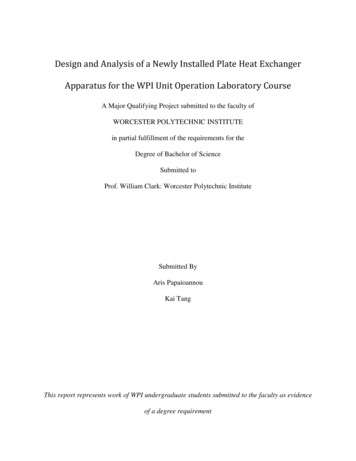
Transcription
Design and Analysis of a Newly Installed Plate Heat ExchangerApparatus for the WPI Unit Operation Laboratory CourseA Major Qualifying Project submitted to the faculty ofWORCESTER POLYTECHNIC INSTITUTEin partial fulfillment of the requirements for theDegree of Bachelor of ScienceSubmitted toProf. William Clark: Worcester Polytechnic InstituteSubmitted ByAris PapaioannouKai TangThis report represents work of WPI undergraduate students submitted to the faculty as evidenceof a degree requirement
AbstractThe goals of this project were to design a plate heat exchanger apparatus and evaluate the potentialof replacing the current double pipe heat exchanger by this newly designed plate heat exchangerfor the Unit Operation Laboratory Course. Raw data was collected during experiments. The goalsfor this project were achieved, as the team accomplished all objectives for the Heat ExchangerUnit Operation Experiment. The results obtained from the plate heat exchanger apparatus wereconsistent with the governing theory compared to the results from the double pipe heat exchangerapparatus.
AcknowledgementsWe would like to thank our advisor, Professor W. M. Clark, for his guidance and supportthroughout this project; without his overall contribution this project would not be possible.We would also like to thank the lab manager of the WPI UO lab, Tom Partington, for his help withordering the necessary parts and constructing the mounting stud upon which the plate heatexchanger was mounted.
Contents1. Introduction . 52. Background . 82.1 Heat Transfer Theory. 82.2 Heat Transfer in Heat Exchanger . 92.3 Types of heat exchangers .112.4 Comparison of Plate and Double Pipe heat exchangers .143. Methodology .163.1 Process development and apparatus installation .163.2 Test of the system .183.3 Improvements made to the system .193.4 Experimental process .193.5 Data Analysis .204. Results and Discussion .224.1 Heat Loss .224.2 Percentage of heat loss .234.4 Effects of flow pattern .245. Conclusions and recommendations .275.1 Conclusions .275.2 Recommendations.28Reference .28Appendix .30Appendix A Experimental Data .31Appendix B Analyzed data.35Appendix C Sample Calculation for heat loss (Run 1) and percentage of Qloss .43Appendix D Calibration Curve for Rotameters .44
1. IntroductionA milestone in the engineering curriculum overall is the study of the transport phenomena whichconsist of three interconnected branches; heat transfer, mass transfer and fluid mechanics. Heattransfer in particular is of paramount interest to chemical engineers who deal with a plethora ofprocesses which involve the consumption and/or generation of energy, very often in the form ofheat. From common daily processes, such as home heating, cooking and others to virtually allindustrial processes independently of their scale, heat is transferred - exchanged - between one ormore fluids - even in humans the nasal passages operate as heat exchangers during inhaling andexhaling. Heat exchangers are the devices used to transfer heat between one or more fluids andserve as an important processing equipment in various industrial processes ranging fromwastewater treatment facilities to petroleum refineries and wineries.The Unit Operations course offers students majoring in chemical engineering the chance to applykey concepts acquired throughout the chemical engineering sequence through the study andanalysis of a variety of experiments. The Unit Operations Laboratory of Worcester PolytechnicInstitute utilizes a double pipe heat exchanger to facilitate the analysis and understanding of heattransfer inside a heat exchanger. Water flows inside the inner pipe and steam flows through theannulus formed between the two pipes. A cross section view a double pipe heat exchangerrepresenting the one used in the WPI UO lab is provided in the following schematic.
Brass heatexchanger innerOuter pipe; steam inside,well insulated outside.Water flowing through pipe inturbulent flow; Ta known at entrance.Steam in outer pipe; Pand T known; thin filmcondensing on outsideof inner pipe, drippingoff and collecting insteam trap.Figure 1: Cross section view of WPI’s UO lab double pipe heat exchanger [1]Students run the experiment and are able to vary the water flowrate, the steam pressure andinterchange the flow pattern between co-current (also known as parallel) and countercurrent flow.The main key concepts investigated include the dependency of the overall and individual - that isthe water side and steam side - heat transfer coefficients upon operating conditions such as thewater flowrate and steam pressure and the effect of the flow pattern on the transfer of heat insidethe exchanger. In the double pipe heat exchanger of the WPI Unit Operations Lab where steamcondenses in the outer pipe and consequently transfers heat to the water flowing in the inner pipe,it is expected that the flow pattern should not have an impact on the overall transfer of heat betweenthe two fluids - mainly dictated by the heat transfer coefficients - since as steam condenses itstemperature remains constant as it undergoes a phase change from vapor to liquid. Therefore, asthe temperature of one of the two fluids remains the same so does the temperature gradient acrossthe pipe, the driving force of the transfer of heat between two bodies with different temperatures,and therefore co-current and countercurrent flow are expected to yield the same results. However,
students running the experiment often observed higher heat transfer coefficients when operatingon co-current flow than in countercurrent. The discrepancies arose mainly due to the configurationof the double pipe heat exchanger and the structure of the experiment itself as often volumes ofhot water (condensed steam) were trapped at the water inlet from previous experimental runsleading to ‘distorted’ readings and thus to an overall analysis which would not coincide with thegoverning theory. Moreover, the cost of the steam supplied by the campus-wide steam plant to thedouble pipe heat exchanger has also become an issue during the past few years.The possibility of replacing the current double pipe heat exchanger used in the WPI UnitOperations laboratory due to mainly the aforementioned reasons provides the incentive of thisstudy. In particular, this project focuses on the operation and analysis of a ten-plate heat exchangerwhich will run on cold and hot water supplied from the building’s utility lines aiming atdetermining the feasibility of using this process equipment instead of the current double pipe heatexchanger for the Unit Operations Laboratory course at WPI.
2. BackgroundThis section provides relevant information on heat transfer theory focusing mostly on heat transferinside a heat exchanger and also offers brief background information on the operation of differenttypes of heat exchangers putting emphasis on plate heat exchangers.2.1 Heat Transfer TheoryHeat transfer is the exchange of thermal energy between physical systems by dissipating heat. Thedriving force of heat transfer is the temperature difference between the physical systems that heatis exchanged. The theory of heat transfer from one media to another or from one fluid to anotherfluid is governed by three fundamental principles. First, heat always transfers from a region ofhigh temperature to another region of lower temperature. Second, there must always be atemperature difference between the media for heat to be transferred. Lastly, the heat lost by theregion of higher temperature must equal the amount of heat gained by the region of lowertemperature except for losses to the surroundings.Heat can be transferred through four fundamental methods, also known as modes of heat transfer,and include advection, conduction or diffusion, convection and radiation. Briefly, advectiondescribes the transfer of heat by the flow or movement of a fluid or a body respectively from onelocation to another and is dependent upon displacement and momentum. Conduction or diffusionrefers to the transfer of heat between solids or fluids that are in physical contact and arises fromthe rapid movement/vibration of atoms and molecules which transfer part of their energy (in theform of heat) to adjacent neighboring particles. Convection is the heat transfer caused by the mass
motion of a fluid when the heated fluid is forced to move away from the source of heat carryingenergy with it in the form of heat. Finally, radiation refers to the transfer of heat due to themovement of charged subatomic particles. Contrary to the other modes of heat transfer radiationdoes not require a medium to take place; radiation can occur in absolute vacuum. In a heatexchanger, heat is transferred through convection and conduction2.2 Heat Transfer in Heat ExchangerIn a heat exchanger, heat is first transferred from hot fluid to the surface separating the two fluids(boundary) by convection. Next, heat is transferred through the boundary by conduction. Thenheat is transferred from the boundary to the cold fluid by convection (Cengel et al., 2008). An idealplate heat exchanger can be imagined as a closed system, so energy is conserved in this system,which means the heat lost from the hot water equals to the heat gained by the cold water. In thisproject, the system is not an ideal one, as there are heat losses to the surroundings, so the optimaloperating condition can be determined when the heat transfer efficiency is highest.There are some factors that affect the heat transfer rate which can be deduced from the heat transferequation, the governing equation for the heat transfer rate particularly inside a heat exchanger.𝑄𝑄 𝑈𝑈 𝐴𝐴 𝑇𝑇𝐿𝐿𝐿𝐿Temperature difference between the two fluids provides the driving force for heat exchange. Thusa greater temperature difference will result in a greater heat transfer rate. Moreover, according totheory a higher fluid flow rate (higher fluid velocity) results in a higher heat transfer rate. Theoverall heat transfer coefficient, expressed as U, also dictates the rate at which heat transfer takesplace. The overall heat transfer coefficient (U) is a measure of the overall ability of a series ofconductive and/or convective barriers to promote, or equally resist, transfer of heat. It is a function
of the individual heat transfer coefficients associated with each body or fluid participating in theheat exchange process along with the heat transfer coefficient associated to the medium (solid asthe pipe wall or fluid as in the air) where the transfer of heat takes place and is a measure of themedium’s ability to promote or resist heat transfer and is a function of the medium’s inherentproperties (such as its material, thickness), the conditions (temperature and pressure) and the modeof heat transfer. Thermal conductivity of the building material affects the heat transfer rate in aheat exchanger. Heat exchangers made of materials with higher thermal conductivity (oftendenoted as k) provide higher heat transfer rate. A larger heat transfer surface area also generates ahigher transfer rate according to the heat transfer principle. The surface area available for heattransfer is dictated by the design and manufacture of the exchanger in order to meet the heat loadrequirements. In a tube and shell heat exchanger which consists of a collection of relatively thin,long tubes which provide the surface area available for heat transfer, the more tubes contained inthe bundle the greater the surface area. The tube length also affects the heat tr
Institute utilizes a double pipe heat exchanger to facilitate the analysis and understanding of heat transfer inside a heat exchanger. Water flows inside the inner pipe and steam flows through the annulus formed between the two pipes. A cross section view a double pipe heat exchanger representing the one used in the WPI UO lab is provided in the following schematic. Figure 1: Cross section .



